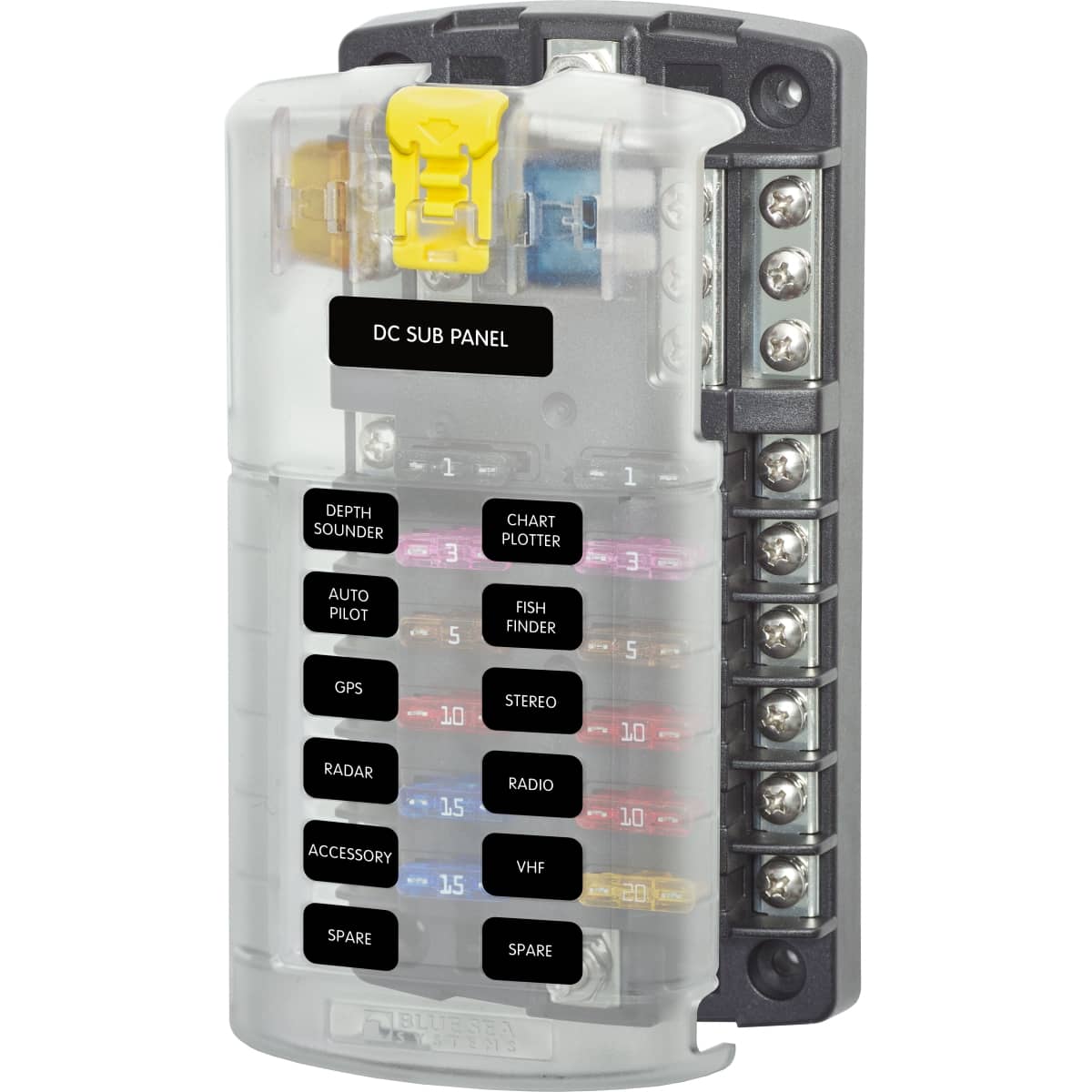Get This Report on Blue Sea Fuse Block
Wiki Article
Blue Sea Fuse Block for Dummies
Table of ContentsAn Unbiased View of Blue Sea Fuse BlockNot known Facts About Blue Sea Fuse BlockHow Blue Sea Fuse Block can Save You Time, Stress, and Money.Blue Sea Fuse Block - TruthsThe Greatest Guide To Blue Sea Fuse BlockThe 2-Minute Rule for Blue Sea Fuse Block
Fuses are bolted in position in between the bus bar and also the second collection of electrically isolated bolts. With this setup you can connect the watercraft's different high-current circuits, such as a windlass, bow thruster, high-output generator, the DC panel, etc, to the isolated screws. The different fuses are sized according to the current-carrying capacity of the conductors bolted to them.Some circuits will still need to bypass the seclusion switch to ensure that they might be left on when the remainder of the watercraft is shut down. blue sea fuse block. These circuits usually consist of a bilge pump and also any kind of billing gadgets (including solar panels, perhaps a wind generator, as well as the inverter if it also doubles as a battery charger).
This belongs to the circuit layout we created for the complex example boat in our Boat Electrics course. The tools linked to the fuse block in the top right are all bypassing the isolation switch S1. If you enroll in Boat Electrics 101, you will certainly find out just how to review such a representation and also exactly how to make one for your own boat.
Rumored Buzz on Blue Sea Fuse Block

The goal is to give protection at the resource of power for each circuit. With DC circuits, the OCP is always put in the favorable side of DC circuits. (Aside from anything else, an unbroken link to DC adverse must be preserved in all times to protect against stray-current rust.) Keep in mind that some European boatbuilders mount fuses as well as battery buttons in the DC adverse side and also on the positive side, but this is not suggested other than in some separated (floating) ground DC systems.
This point might go to the battery, the battery switch, the distribution panel, a subsidiary panel, some circulation bus bar, or other connecting point. If the conductors in the brand-new circuit are no smaller sized than the conductor that feeds the brand-new circuit's point of link, after that the OCP for the feeder conductor will sufficiently safeguard the brand-new circuit - blue sea fuse block.
The Best Guide To Blue Sea Fuse Block
But if the brand-new circuit is not sufficiently offered by overcurrent devices already in area, additional security is required at its point of connection, i. e., at its resource of power. Positioning of fuses in the favorable conductor. Keep in mind exactly how a smaller fuse is used every time a smaller conductor is linked, Sometimes area restricts exactly how close an OCP tool can be placed to the source of power.The generic answer, from the ABYC, is within 7" (17. The ABYC allows the following, which have actually been tightened up in current years: A conductor linked directly to a battery that is likewise "included throughout its entire range in a sheath or unit such as an avenue, junction box, control box or enclosed panel" must have its overcurrent defense "as close as achievable to the battery, however not to exceed 72 inches (1.
Gone is the covering 72" allocation that utilized to be there. A conductor connected to a resource of power various other than the battery (e. g., the battery switch, the distribution panel, or some various other factor in the DC circuits) that is similarly contained in a sheath, and so on, should have its overcurrent protection "as close as achievable to the factor of connection to the resource of power, however not to exceed 40 inches (1.
The Definitive Guide to Blue Sea Fuse Block
Provided that alternators themselves are a source of power, it has been arguable whether these included alternators required OCP at the alternator itself."Cranking-motor circuits are over at this website not needed to have overcurrent security.In the marine area, where cranking circuits might be long, this practice might create a threat. If a car ignites, the occupants can pull over and also leap out. If a watercraft catches fire, it is not so straightforward. It makes no feeling to have any kind of unguarded circuits on a boat.
In winter, the inrush present on a 12V starter motor may be as high as 1,500 amps; the cranking current may be as much as 200 amps. Typically, cranking conductors are undersized also for the cranking present, not to mention the inrush existing. This situation does not posture a safety and security issue in itself, since these currents are sustained for just a few seconds, so the conductors do not have time to fume sufficient to create a fire threat.
Top Guidelines Of Blue Sea Fuse Block
We made the course with absolute novices in mind. As the electric load on watercrafts rises, so also does the complexity of electrical circuits and the possibility for short circuits and electric fires.
In the aquatic area, where cranking circuits may be long, this technique could create a danger. If an automobile ignites, the passengers can pull over and also jump out. If a watercraft ignites, it is not so simple. It makes no sense to have any kind of unprotected circuits on a watercraft.
The Buzz on Blue Sea Fuse Block

We made the course with outright beginners in mind. As the electric lots on watercrafts increases, so check my source also does the intricacy of electric circuits as well as the possibility for short circuits and also electrical fires.
Report this wiki page